Hospitality Business Strategy - Analysis and Recommendations
VerifiedAdded on 2023/06/09
|13
|4356
|283
AI Summary
This report provides a detailed analysis of the hospitality business industry with a focus on Savoy hotel. It includes SWOT analysis, PESTEL analysis, McKinsey's 7s model, Porter's 5 forces, and strategies to improve competitive edge and market position. The report also includes a strategic plan based on environmental analysis and findings.
Contribute Materials
Your contribution can guide someone’s learning journey. Share your
documents today.
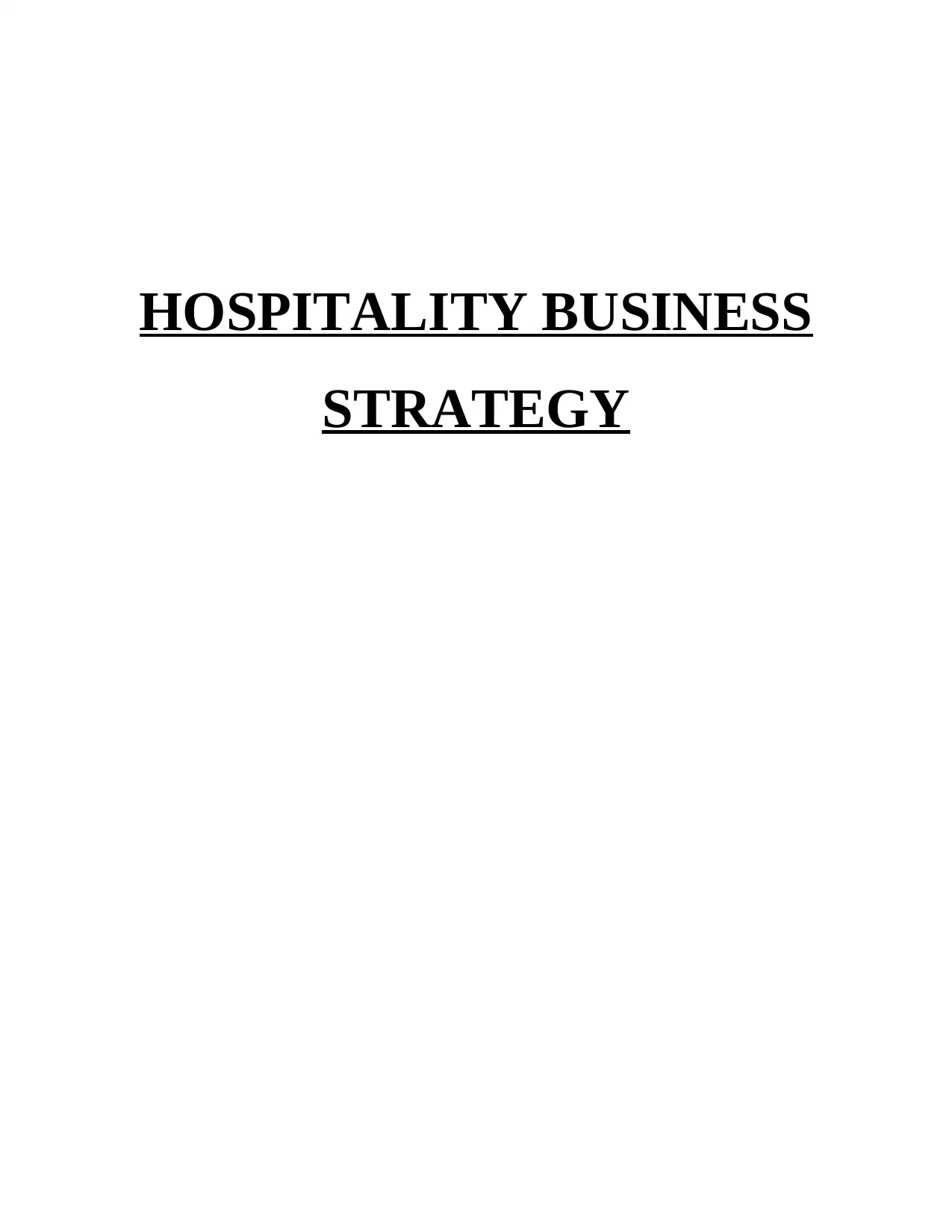
HOSPITALITY BUSINESS
STRATEGY
STRATEGY
Secure Best Marks with AI Grader
Need help grading? Try our AI Grader for instant feedback on your assignments.
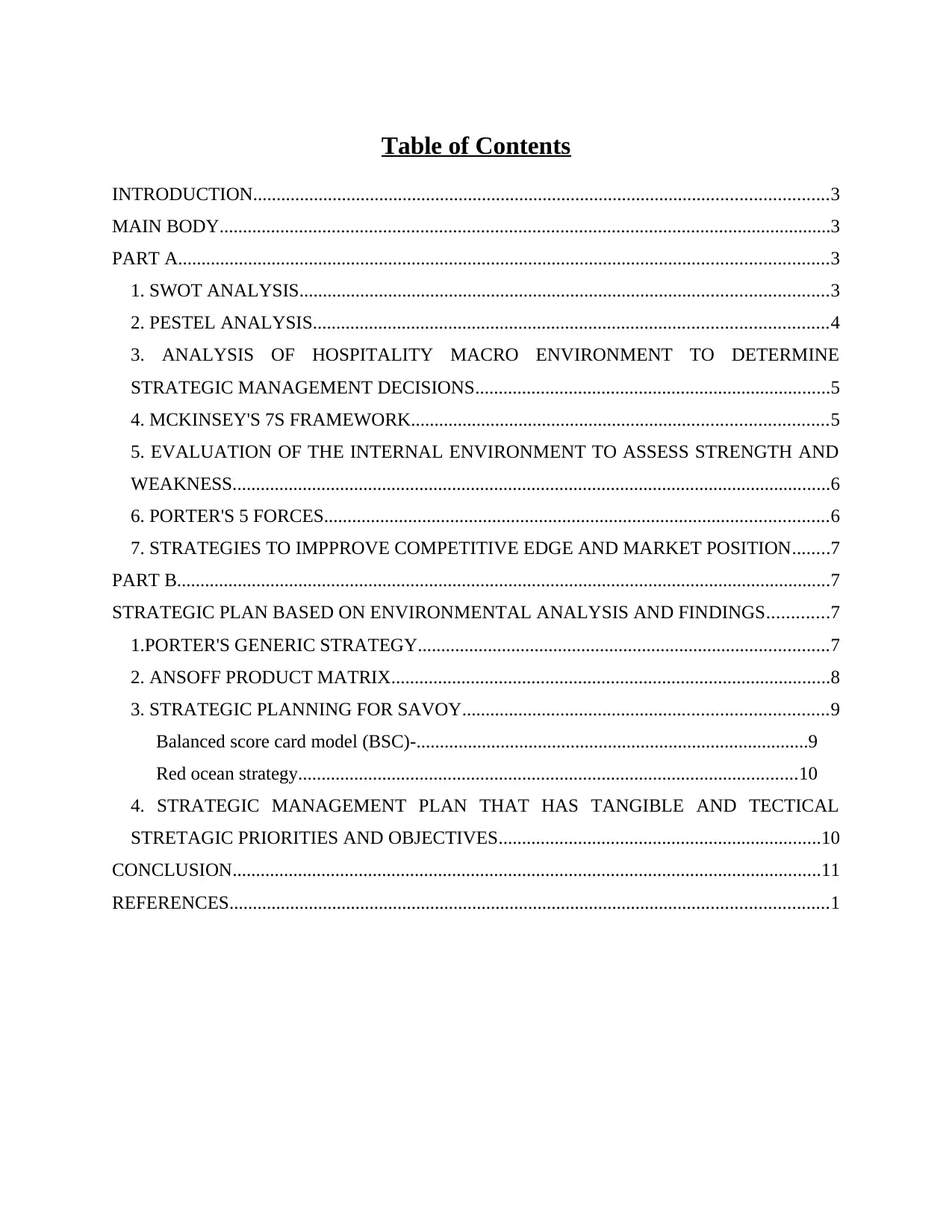
Table of Contents
INTRODUCTION...........................................................................................................................3
MAIN BODY...................................................................................................................................3
PART A...........................................................................................................................................3
1. SWOT ANALYSIS.................................................................................................................3
2. PESTEL ANALYSIS..............................................................................................................4
3. ANALYSIS OF HOSPITALITY MACRO ENVIRONMENT TO DETERMINE
STRATEGIC MANAGEMENT DECISIONS............................................................................5
4. MCKINSEY'S 7S FRAMEWORK.........................................................................................5
5. EVALUATION OF THE INTERNAL ENVIRONMENT TO ASSESS STRENGTH AND
WEAKNESS................................................................................................................................6
6. PORTER'S 5 FORCES............................................................................................................6
7. STRATEGIES TO IMPPROVE COMPETITIVE EDGE AND MARKET POSITION........7
PART B............................................................................................................................................7
STRATEGIC PLAN BASED ON ENVIRONMENTAL ANALYSIS AND FINDINGS.............7
1.PORTER'S GENERIC STRATEGY........................................................................................7
2. ANSOFF PRODUCT MATRIX..............................................................................................8
3. STRATEGIC PLANNING FOR SAVOY..............................................................................9
Balanced score card model (BSC)-....................................................................................9
Red ocean strategy...........................................................................................................10
4. STRATEGIC MANAGEMENT PLAN THAT HAS TANGIBLE AND TECTICAL
STRETAGIC PRIORITIES AND OBJECTIVES.....................................................................10
CONCLUSION..............................................................................................................................11
REFERENCES................................................................................................................................1
INTRODUCTION...........................................................................................................................3
MAIN BODY...................................................................................................................................3
PART A...........................................................................................................................................3
1. SWOT ANALYSIS.................................................................................................................3
2. PESTEL ANALYSIS..............................................................................................................4
3. ANALYSIS OF HOSPITALITY MACRO ENVIRONMENT TO DETERMINE
STRATEGIC MANAGEMENT DECISIONS............................................................................5
4. MCKINSEY'S 7S FRAMEWORK.........................................................................................5
5. EVALUATION OF THE INTERNAL ENVIRONMENT TO ASSESS STRENGTH AND
WEAKNESS................................................................................................................................6
6. PORTER'S 5 FORCES............................................................................................................6
7. STRATEGIES TO IMPPROVE COMPETITIVE EDGE AND MARKET POSITION........7
PART B............................................................................................................................................7
STRATEGIC PLAN BASED ON ENVIRONMENTAL ANALYSIS AND FINDINGS.............7
1.PORTER'S GENERIC STRATEGY........................................................................................7
2. ANSOFF PRODUCT MATRIX..............................................................................................8
3. STRATEGIC PLANNING FOR SAVOY..............................................................................9
Balanced score card model (BSC)-....................................................................................9
Red ocean strategy...........................................................................................................10
4. STRATEGIC MANAGEMENT PLAN THAT HAS TANGIBLE AND TECTICAL
STRETAGIC PRIORITIES AND OBJECTIVES.....................................................................10
CONCLUSION..............................................................................................................................11
REFERENCES................................................................................................................................1

INTRODUCTION
The report of hospitality business industry will cover several vital aspects of business
analysis. For this purpose, the hospitality organization taken is Savoy hotel. Savoy is a UK based
luxury hotel started in 1889, serving more than 34 countries. In part one of the report important
aspect in making business strategy such as SWOT analysis, PESTLE analysis, McKinsey's 7s
model, Porter's 5 forces will be briefly discussed.
Further, the report will also include critically analysis of the hospitality macro
environment in order to determine strategic management decisions and the internal environment
to assess strengths and weaknesses of Savoy's internal capabilities, structure and skill set
(BURKE and et.al., 2020). At last appropriate strategies to improve competitive edge will also be
mentioned. In part two, Porter's generic strategies, ANSOFF matrix, a strategic management plan
that has tangible and tactical strategic priorities, explanation of the strategic process in the
organization.
MAIN BODY
PART A
1. SWOT ANALYSIS
SWOT stands for strengths, weakness, opportunities and threats. Each of these is
discussed below.
Strengths:
1. Years of experience which brings extreme
expertise.
2. Huge customer base, which generates large
revenues & incurs huge profits.
3. Strong brand image and strong asset
portfolio.
Weaknesses:
1. It does not cater to multiple segments.
2. High cost of maintenance due to luxurious
affairs.
3. Poor customization of services, as it incurs
high cost (Cheng and et.al., 2021).
Opportunities:
1. Business expansion across various
demographics.
2. Using customization of services to improve
quality of experience for each customer.
Threats:
1. Pandemic, as Covid-19 pauses a big threat to
Savoy.
2. High competition affects the target market to
switch to another hotel.
The report of hospitality business industry will cover several vital aspects of business
analysis. For this purpose, the hospitality organization taken is Savoy hotel. Savoy is a UK based
luxury hotel started in 1889, serving more than 34 countries. In part one of the report important
aspect in making business strategy such as SWOT analysis, PESTLE analysis, McKinsey's 7s
model, Porter's 5 forces will be briefly discussed.
Further, the report will also include critically analysis of the hospitality macro
environment in order to determine strategic management decisions and the internal environment
to assess strengths and weaknesses of Savoy's internal capabilities, structure and skill set
(BURKE and et.al., 2020). At last appropriate strategies to improve competitive edge will also be
mentioned. In part two, Porter's generic strategies, ANSOFF matrix, a strategic management plan
that has tangible and tactical strategic priorities, explanation of the strategic process in the
organization.
MAIN BODY
PART A
1. SWOT ANALYSIS
SWOT stands for strengths, weakness, opportunities and threats. Each of these is
discussed below.
Strengths:
1. Years of experience which brings extreme
expertise.
2. Huge customer base, which generates large
revenues & incurs huge profits.
3. Strong brand image and strong asset
portfolio.
Weaknesses:
1. It does not cater to multiple segments.
2. High cost of maintenance due to luxurious
affairs.
3. Poor customization of services, as it incurs
high cost (Cheng and et.al., 2021).
Opportunities:
1. Business expansion across various
demographics.
2. Using customization of services to improve
quality of experience for each customer.
Threats:
1. Pandemic, as Covid-19 pauses a big threat to
Savoy.
2. High competition affects the target market to
switch to another hotel.
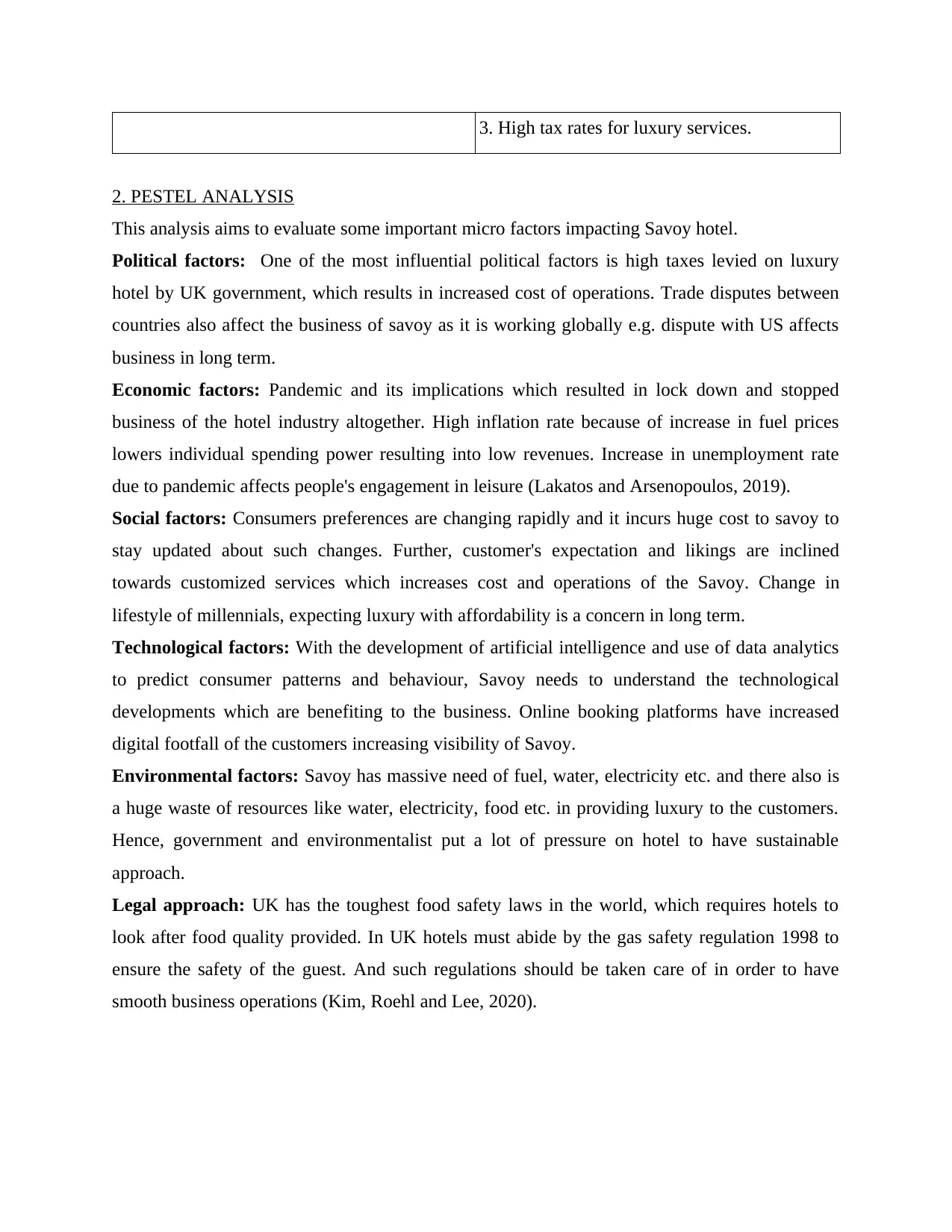
3. High tax rates for luxury services.
2. PESTEL ANALYSIS
This analysis aims to evaluate some important micro factors impacting Savoy hotel.
Political factors: One of the most influential political factors is high taxes levied on luxury
hotel by UK government, which results in increased cost of operations. Trade disputes between
countries also affect the business of savoy as it is working globally e.g. dispute with US affects
business in long term.
Economic factors: Pandemic and its implications which resulted in lock down and stopped
business of the hotel industry altogether. High inflation rate because of increase in fuel prices
lowers individual spending power resulting into low revenues. Increase in unemployment rate
due to pandemic affects people's engagement in leisure (Lakatos and Arsenopoulos, 2019).
Social factors: Consumers preferences are changing rapidly and it incurs huge cost to savoy to
stay updated about such changes. Further, customer's expectation and likings are inclined
towards customized services which increases cost and operations of the Savoy. Change in
lifestyle of millennials, expecting luxury with affordability is a concern in long term.
Technological factors: With the development of artificial intelligence and use of data analytics
to predict consumer patterns and behaviour, Savoy needs to understand the technological
developments which are benefiting to the business. Online booking platforms have increased
digital footfall of the customers increasing visibility of Savoy.
Environmental factors: Savoy has massive need of fuel, water, electricity etc. and there also is
a huge waste of resources like water, electricity, food etc. in providing luxury to the customers.
Hence, government and environmentalist put a lot of pressure on hotel to have sustainable
approach.
Legal approach: UK has the toughest food safety laws in the world, which requires hotels to
look after food quality provided. In UK hotels must abide by the gas safety regulation 1998 to
ensure the safety of the guest. And such regulations should be taken care of in order to have
smooth business operations (Kim, Roehl and Lee, 2020).
2. PESTEL ANALYSIS
This analysis aims to evaluate some important micro factors impacting Savoy hotel.
Political factors: One of the most influential political factors is high taxes levied on luxury
hotel by UK government, which results in increased cost of operations. Trade disputes between
countries also affect the business of savoy as it is working globally e.g. dispute with US affects
business in long term.
Economic factors: Pandemic and its implications which resulted in lock down and stopped
business of the hotel industry altogether. High inflation rate because of increase in fuel prices
lowers individual spending power resulting into low revenues. Increase in unemployment rate
due to pandemic affects people's engagement in leisure (Lakatos and Arsenopoulos, 2019).
Social factors: Consumers preferences are changing rapidly and it incurs huge cost to savoy to
stay updated about such changes. Further, customer's expectation and likings are inclined
towards customized services which increases cost and operations of the Savoy. Change in
lifestyle of millennials, expecting luxury with affordability is a concern in long term.
Technological factors: With the development of artificial intelligence and use of data analytics
to predict consumer patterns and behaviour, Savoy needs to understand the technological
developments which are benefiting to the business. Online booking platforms have increased
digital footfall of the customers increasing visibility of Savoy.
Environmental factors: Savoy has massive need of fuel, water, electricity etc. and there also is
a huge waste of resources like water, electricity, food etc. in providing luxury to the customers.
Hence, government and environmentalist put a lot of pressure on hotel to have sustainable
approach.
Legal approach: UK has the toughest food safety laws in the world, which requires hotels to
look after food quality provided. In UK hotels must abide by the gas safety regulation 1998 to
ensure the safety of the guest. And such regulations should be taken care of in order to have
smooth business operations (Kim, Roehl and Lee, 2020).
Secure Best Marks with AI Grader
Need help grading? Try our AI Grader for instant feedback on your assignments.
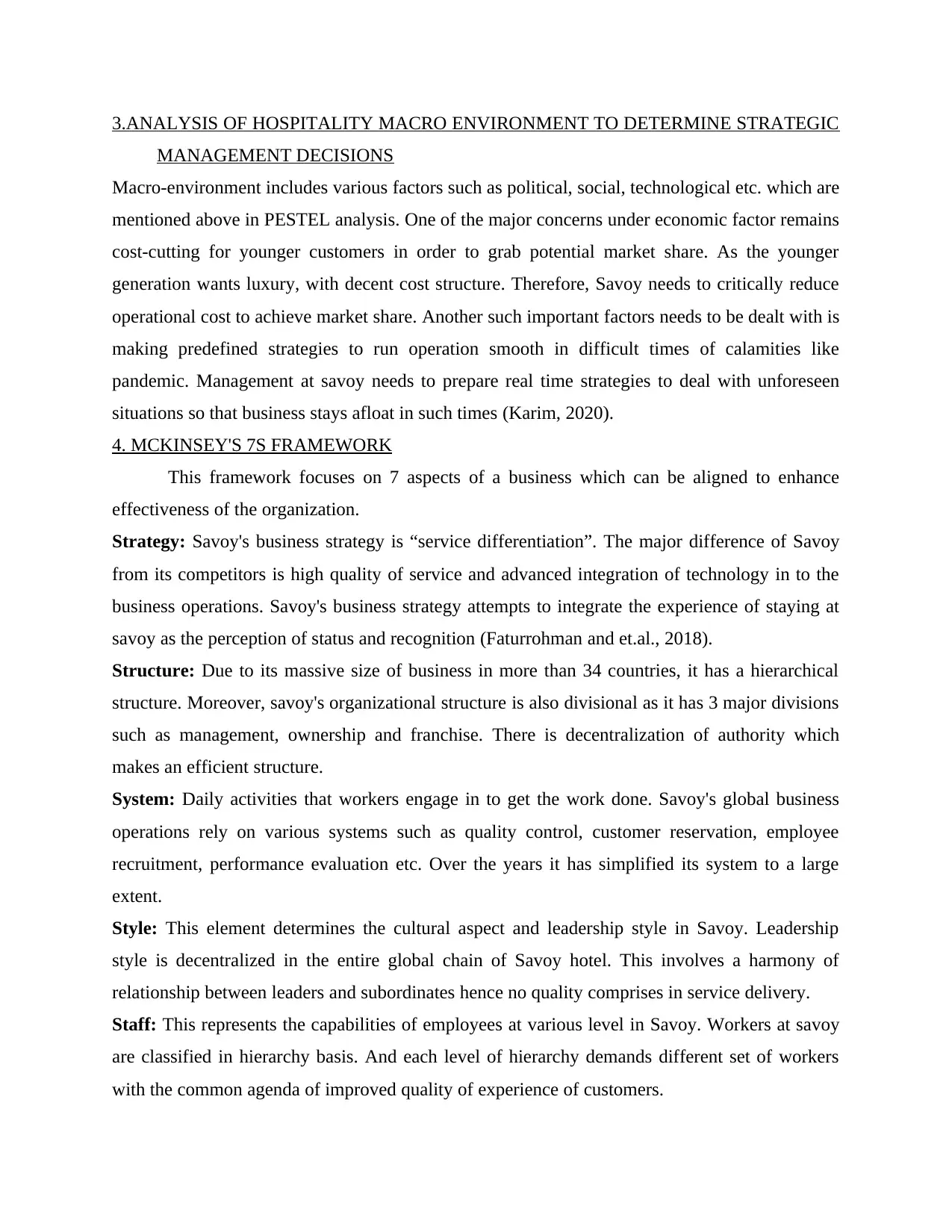
3.ANALYSIS OF HOSPITALITY MACRO ENVIRONMENT TO DETERMINE STRATEGIC
MANAGEMENT DECISIONS
Macro-environment includes various factors such as political, social, technological etc. which are
mentioned above in PESTEL analysis. One of the major concerns under economic factor remains
cost-cutting for younger customers in order to grab potential market share. As the younger
generation wants luxury, with decent cost structure. Therefore, Savoy needs to critically reduce
operational cost to achieve market share. Another such important factors needs to be dealt with is
making predefined strategies to run operation smooth in difficult times of calamities like
pandemic. Management at savoy needs to prepare real time strategies to deal with unforeseen
situations so that business stays afloat in such times (Karim, 2020).
4. MCKINSEY'S 7S FRAMEWORK
This framework focuses on 7 aspects of a business which can be aligned to enhance
effectiveness of the organization.
Strategy: Savoy's business strategy is “service differentiation”. The major difference of Savoy
from its competitors is high quality of service and advanced integration of technology in to the
business operations. Savoy's business strategy attempts to integrate the experience of staying at
savoy as the perception of status and recognition (Faturrohman and et.al., 2018).
Structure: Due to its massive size of business in more than 34 countries, it has a hierarchical
structure. Moreover, savoy's organizational structure is also divisional as it has 3 major divisions
such as management, ownership and franchise. There is decentralization of authority which
makes an efficient structure.
System: Daily activities that workers engage in to get the work done. Savoy's global business
operations rely on various systems such as quality control, customer reservation, employee
recruitment, performance evaluation etc. Over the years it has simplified its system to a large
extent.
Style: This element determines the cultural aspect and leadership style in Savoy. Leadership
style is decentralized in the entire global chain of Savoy hotel. This involves a harmony of
relationship between leaders and subordinates hence no quality comprises in service delivery.
Staff: This represents the capabilities of employees at various level in Savoy. Workers at savoy
are classified in hierarchy basis. And each level of hierarchy demands different set of workers
with the common agenda of improved quality of experience of customers.
MANAGEMENT DECISIONS
Macro-environment includes various factors such as political, social, technological etc. which are
mentioned above in PESTEL analysis. One of the major concerns under economic factor remains
cost-cutting for younger customers in order to grab potential market share. As the younger
generation wants luxury, with decent cost structure. Therefore, Savoy needs to critically reduce
operational cost to achieve market share. Another such important factors needs to be dealt with is
making predefined strategies to run operation smooth in difficult times of calamities like
pandemic. Management at savoy needs to prepare real time strategies to deal with unforeseen
situations so that business stays afloat in such times (Karim, 2020).
4. MCKINSEY'S 7S FRAMEWORK
This framework focuses on 7 aspects of a business which can be aligned to enhance
effectiveness of the organization.
Strategy: Savoy's business strategy is “service differentiation”. The major difference of Savoy
from its competitors is high quality of service and advanced integration of technology in to the
business operations. Savoy's business strategy attempts to integrate the experience of staying at
savoy as the perception of status and recognition (Faturrohman and et.al., 2018).
Structure: Due to its massive size of business in more than 34 countries, it has a hierarchical
structure. Moreover, savoy's organizational structure is also divisional as it has 3 major divisions
such as management, ownership and franchise. There is decentralization of authority which
makes an efficient structure.
System: Daily activities that workers engage in to get the work done. Savoy's global business
operations rely on various systems such as quality control, customer reservation, employee
recruitment, performance evaluation etc. Over the years it has simplified its system to a large
extent.
Style: This element determines the cultural aspect and leadership style in Savoy. Leadership
style is decentralized in the entire global chain of Savoy hotel. This involves a harmony of
relationship between leaders and subordinates hence no quality comprises in service delivery.
Staff: This represents the capabilities of employees at various level in Savoy. Workers at savoy
are classified in hierarchy basis. And each level of hierarchy demands different set of workers
with the common agenda of improved quality of experience of customers.

Skills: There are various training programs and skill development programs run in order to
update and improve the working of the staff. Hotel managers at savoy need various sort of skills
in order to manage each segment of hotel efficiently. Savoy is working globally so it also needs
to understand training requirement based on different locations (Ward, 2021)
Shared values: Values are the centre part of this model as shared values are the centre of growth
and development of savoy. Savoy's values are, providing utmost comfort and luxury to the
customer, and this remains clear to the employees which impact operations positively.
5. EVALUATION OF THE INTERNAL ENVIRONMENT TO ASSESS STRENGTH AND
WEAKNESS.
Savoy's internal environment's strength is well authorized and structured operations. Savoy is in
the business for over 100 years which has brought strong set of skills for management and
hospitality (Razmi, Mehrvar, and Hassani, 2020) Strong expertise in serving customers and zero
compromise in providing luxury services has been the greatest forte. Further, huge cost of
operations and fixed capital maintenance is a weakness for Savoy. Such huge cost remains a
threat in recessions nd pandemic times. Lack in delegation of management duties is another
loophole in the environment. As this leads to the waste of time and efforts for the company.
6. PORTER'S 5 FORCES
This framework of Porter analyses the organization's competitive environment. Let's
discuss porter's 5 forces in detail.
Power of suppliers: Suppliers are more powerful if they are concentrated. For hotel industry
power of suppliers lies in the hotel's human resources, food and beverage supplies. Savoy is
service provider totally dependent on its employees for delivering services. And there is a high
demand of trained experienced personnels in hotel industry which makes bargaining power of
supplier’s medium for savoy (Ibrahim and et.al., 2018).
Power of buyers: Bargaining power of individual customers is really low at savoy as an
individual can't drive the prices low but tour operator, travel companies who buy rooms in bulk
have more bargaining power and capability to drive prices low in long term. Savoy's bargaining
power of buyers differs significantly depending upon the target buyer group.
Threat of new entrants: This threat of new entrants remains low for savoy because of
economies of scale, it requires strong brand image, huge fixed cost, large working capital to run
update and improve the working of the staff. Hotel managers at savoy need various sort of skills
in order to manage each segment of hotel efficiently. Savoy is working globally so it also needs
to understand training requirement based on different locations (Ward, 2021)
Shared values: Values are the centre part of this model as shared values are the centre of growth
and development of savoy. Savoy's values are, providing utmost comfort and luxury to the
customer, and this remains clear to the employees which impact operations positively.
5. EVALUATION OF THE INTERNAL ENVIRONMENT TO ASSESS STRENGTH AND
WEAKNESS.
Savoy's internal environment's strength is well authorized and structured operations. Savoy is in
the business for over 100 years which has brought strong set of skills for management and
hospitality (Razmi, Mehrvar, and Hassani, 2020) Strong expertise in serving customers and zero
compromise in providing luxury services has been the greatest forte. Further, huge cost of
operations and fixed capital maintenance is a weakness for Savoy. Such huge cost remains a
threat in recessions nd pandemic times. Lack in delegation of management duties is another
loophole in the environment. As this leads to the waste of time and efforts for the company.
6. PORTER'S 5 FORCES
This framework of Porter analyses the organization's competitive environment. Let's
discuss porter's 5 forces in detail.
Power of suppliers: Suppliers are more powerful if they are concentrated. For hotel industry
power of suppliers lies in the hotel's human resources, food and beverage supplies. Savoy is
service provider totally dependent on its employees for delivering services. And there is a high
demand of trained experienced personnels in hotel industry which makes bargaining power of
supplier’s medium for savoy (Ibrahim and et.al., 2018).
Power of buyers: Bargaining power of individual customers is really low at savoy as an
individual can't drive the prices low but tour operator, travel companies who buy rooms in bulk
have more bargaining power and capability to drive prices low in long term. Savoy's bargaining
power of buyers differs significantly depending upon the target buyer group.
Threat of new entrants: This threat of new entrants remains low for savoy because of
economies of scale, it requires strong brand image, huge fixed cost, large working capital to run
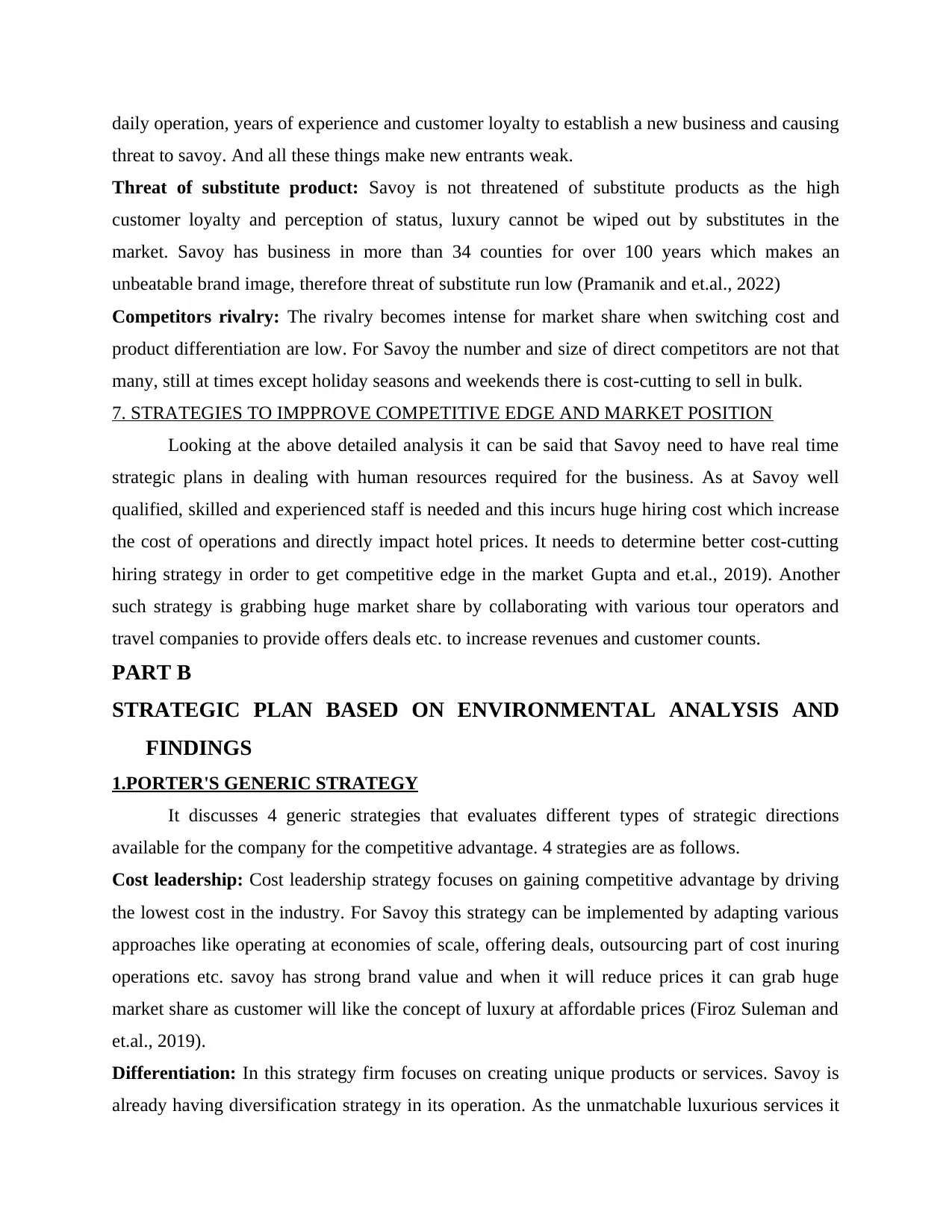
daily operation, years of experience and customer loyalty to establish a new business and causing
threat to savoy. And all these things make new entrants weak.
Threat of substitute product: Savoy is not threatened of substitute products as the high
customer loyalty and perception of status, luxury cannot be wiped out by substitutes in the
market. Savoy has business in more than 34 counties for over 100 years which makes an
unbeatable brand image, therefore threat of substitute run low (Pramanik and et.al., 2022)
Competitors rivalry: The rivalry becomes intense for market share when switching cost and
product differentiation are low. For Savoy the number and size of direct competitors are not that
many, still at times except holiday seasons and weekends there is cost-cutting to sell in bulk.
7. STRATEGIES TO IMPPROVE COMPETITIVE EDGE AND MARKET POSITION
Looking at the above detailed analysis it can be said that Savoy need to have real time
strategic plans in dealing with human resources required for the business. As at Savoy well
qualified, skilled and experienced staff is needed and this incurs huge hiring cost which increase
the cost of operations and directly impact hotel prices. It needs to determine better cost-cutting
hiring strategy in order to get competitive edge in the market Gupta and et.al., 2019). Another
such strategy is grabbing huge market share by collaborating with various tour operators and
travel companies to provide offers deals etc. to increase revenues and customer counts.
PART B
STRATEGIC PLAN BASED ON ENVIRONMENTAL ANALYSIS AND
FINDINGS
1.PORTER'S GENERIC STRATEGY
It discusses 4 generic strategies that evaluates different types of strategic directions
available for the company for the competitive advantage. 4 strategies are as follows.
Cost leadership: Cost leadership strategy focuses on gaining competitive advantage by driving
the lowest cost in the industry. For Savoy this strategy can be implemented by adapting various
approaches like operating at economies of scale, offering deals, outsourcing part of cost inuring
operations etc. savoy has strong brand value and when it will reduce prices it can grab huge
market share as customer will like the concept of luxury at affordable prices (Firoz Suleman and
et.al., 2019).
Differentiation: In this strategy firm focuses on creating unique products or services. Savoy is
already having diversification strategy in its operation. As the unmatchable luxurious services it
threat to savoy. And all these things make new entrants weak.
Threat of substitute product: Savoy is not threatened of substitute products as the high
customer loyalty and perception of status, luxury cannot be wiped out by substitutes in the
market. Savoy has business in more than 34 counties for over 100 years which makes an
unbeatable brand image, therefore threat of substitute run low (Pramanik and et.al., 2022)
Competitors rivalry: The rivalry becomes intense for market share when switching cost and
product differentiation are low. For Savoy the number and size of direct competitors are not that
many, still at times except holiday seasons and weekends there is cost-cutting to sell in bulk.
7. STRATEGIES TO IMPPROVE COMPETITIVE EDGE AND MARKET POSITION
Looking at the above detailed analysis it can be said that Savoy need to have real time
strategic plans in dealing with human resources required for the business. As at Savoy well
qualified, skilled and experienced staff is needed and this incurs huge hiring cost which increase
the cost of operations and directly impact hotel prices. It needs to determine better cost-cutting
hiring strategy in order to get competitive edge in the market Gupta and et.al., 2019). Another
such strategy is grabbing huge market share by collaborating with various tour operators and
travel companies to provide offers deals etc. to increase revenues and customer counts.
PART B
STRATEGIC PLAN BASED ON ENVIRONMENTAL ANALYSIS AND
FINDINGS
1.PORTER'S GENERIC STRATEGY
It discusses 4 generic strategies that evaluates different types of strategic directions
available for the company for the competitive advantage. 4 strategies are as follows.
Cost leadership: Cost leadership strategy focuses on gaining competitive advantage by driving
the lowest cost in the industry. For Savoy this strategy can be implemented by adapting various
approaches like operating at economies of scale, offering deals, outsourcing part of cost inuring
operations etc. savoy has strong brand value and when it will reduce prices it can grab huge
market share as customer will like the concept of luxury at affordable prices (Firoz Suleman and
et.al., 2019).
Differentiation: In this strategy firm focuses on creating unique products or services. Savoy is
already having diversification strategy in its operation. As the unmatchable luxurious services it
Paraphrase This Document
Need a fresh take? Get an instant paraphrase of this document with our AI Paraphraser

is offering, there is no such substitute in the market. It has also a strong customer loyalty due to
service diversification. Customer retention is strong as the loyalty programme is customer
centric.
Cost focus: When a firm focus on serving a niche market by providing aggressive prices for the
same, it is the cost focus strategy. Savoy can focus on a specific market based on age group,
geography and region. Providing competitive prices to such niche segment can foster the
revenues of the company (Gorondutse and Hilman, 2019).
Differentiation focus: This strategy focuses on serving a niche market with unique products
built according to the requirement of the consumers in niche market. Company can adapt this
strategy by focusing on a niche market and catering services according to the need of those
consumers. e.g. Savoy can provide various deals, offers, packs and membership benefits to the
business class.
2. ANSOFF PRODUCT MATRIX
It is an expansion grid for the businesses, offering 4 strategies to grow the business
further. 4 important strategies are as follows.
Market penetration: This consists of increasing sales in existing market with selling existing
products. Company can use this strategy to attract more customers in current hotels by providing
promotional offers, better marketing. This is a low risk approach as savoy already has its hotels
in 34 countries where it can improve marketing and similar approaches to gain or expand market
share (Dawes, 2018).
Product development: In this strategy organizations introduce new product altogether in the
same markets. Savoy has to adapt market environment and this could be a potential strategy for
the same. In the recent times Airbnb has gain a lot of popularity by providing variety of
accommodation at cheaper rates, savoy can use this strategy by creating new hotels and facilities
with affordable rates (Murphy and et.al., 2018).
Market development: In this strategy company can develop new markets altogether to expand
the business. Savoy is operating currently in 34 countries and there are many countries and
regions which are yet to be explored. Therefore, catering hospitality services to new markets can
be a great strategy for the company to expand.
Diversification: The concept of introducing new product to a new market altogether is
diversification. Finding new profitable markets for luxury hotels is not practical enough because
service diversification. Customer retention is strong as the loyalty programme is customer
centric.
Cost focus: When a firm focus on serving a niche market by providing aggressive prices for the
same, it is the cost focus strategy. Savoy can focus on a specific market based on age group,
geography and region. Providing competitive prices to such niche segment can foster the
revenues of the company (Gorondutse and Hilman, 2019).
Differentiation focus: This strategy focuses on serving a niche market with unique products
built according to the requirement of the consumers in niche market. Company can adapt this
strategy by focusing on a niche market and catering services according to the need of those
consumers. e.g. Savoy can provide various deals, offers, packs and membership benefits to the
business class.
2. ANSOFF PRODUCT MATRIX
It is an expansion grid for the businesses, offering 4 strategies to grow the business
further. 4 important strategies are as follows.
Market penetration: This consists of increasing sales in existing market with selling existing
products. Company can use this strategy to attract more customers in current hotels by providing
promotional offers, better marketing. This is a low risk approach as savoy already has its hotels
in 34 countries where it can improve marketing and similar approaches to gain or expand market
share (Dawes, 2018).
Product development: In this strategy organizations introduce new product altogether in the
same markets. Savoy has to adapt market environment and this could be a potential strategy for
the same. In the recent times Airbnb has gain a lot of popularity by providing variety of
accommodation at cheaper rates, savoy can use this strategy by creating new hotels and facilities
with affordable rates (Murphy and et.al., 2018).
Market development: In this strategy company can develop new markets altogether to expand
the business. Savoy is operating currently in 34 countries and there are many countries and
regions which are yet to be explored. Therefore, catering hospitality services to new markets can
be a great strategy for the company to expand.
Diversification: The concept of introducing new product to a new market altogether is
diversification. Finding new profitable markets for luxury hotels is not practical enough because
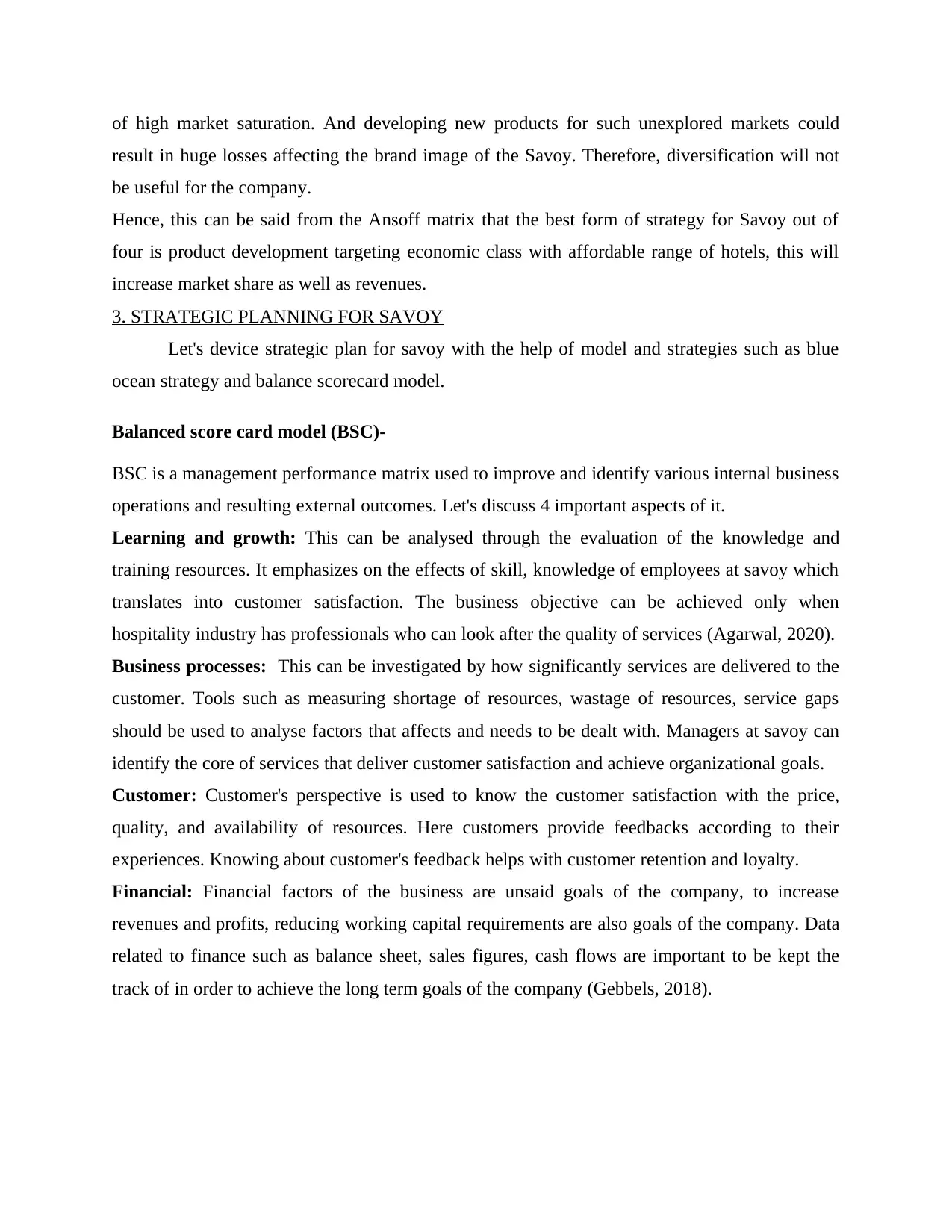
of high market saturation. And developing new products for such unexplored markets could
result in huge losses affecting the brand image of the Savoy. Therefore, diversification will not
be useful for the company.
Hence, this can be said from the Ansoff matrix that the best form of strategy for Savoy out of
four is product development targeting economic class with affordable range of hotels, this will
increase market share as well as revenues.
3. STRATEGIC PLANNING FOR SAVOY
Let's device strategic plan for savoy with the help of model and strategies such as blue
ocean strategy and balance scorecard model.
Balanced score card model (BSC)-
BSC is a management performance matrix used to improve and identify various internal business
operations and resulting external outcomes. Let's discuss 4 important aspects of it.
Learning and growth: This can be analysed through the evaluation of the knowledge and
training resources. It emphasizes on the effects of skill, knowledge of employees at savoy which
translates into customer satisfaction. The business objective can be achieved only when
hospitality industry has professionals who can look after the quality of services (Agarwal, 2020).
Business processes: This can be investigated by how significantly services are delivered to the
customer. Tools such as measuring shortage of resources, wastage of resources, service gaps
should be used to analyse factors that affects and needs to be dealt with. Managers at savoy can
identify the core of services that deliver customer satisfaction and achieve organizational goals.
Customer: Customer's perspective is used to know the customer satisfaction with the price,
quality, and availability of resources. Here customers provide feedbacks according to their
experiences. Knowing about customer's feedback helps with customer retention and loyalty.
Financial: Financial factors of the business are unsaid goals of the company, to increase
revenues and profits, reducing working capital requirements are also goals of the company. Data
related to finance such as balance sheet, sales figures, cash flows are important to be kept the
track of in order to achieve the long term goals of the company (Gebbels, 2018).
result in huge losses affecting the brand image of the Savoy. Therefore, diversification will not
be useful for the company.
Hence, this can be said from the Ansoff matrix that the best form of strategy for Savoy out of
four is product development targeting economic class with affordable range of hotels, this will
increase market share as well as revenues.
3. STRATEGIC PLANNING FOR SAVOY
Let's device strategic plan for savoy with the help of model and strategies such as blue
ocean strategy and balance scorecard model.
Balanced score card model (BSC)-
BSC is a management performance matrix used to improve and identify various internal business
operations and resulting external outcomes. Let's discuss 4 important aspects of it.
Learning and growth: This can be analysed through the evaluation of the knowledge and
training resources. It emphasizes on the effects of skill, knowledge of employees at savoy which
translates into customer satisfaction. The business objective can be achieved only when
hospitality industry has professionals who can look after the quality of services (Agarwal, 2020).
Business processes: This can be investigated by how significantly services are delivered to the
customer. Tools such as measuring shortage of resources, wastage of resources, service gaps
should be used to analyse factors that affects and needs to be dealt with. Managers at savoy can
identify the core of services that deliver customer satisfaction and achieve organizational goals.
Customer: Customer's perspective is used to know the customer satisfaction with the price,
quality, and availability of resources. Here customers provide feedbacks according to their
experiences. Knowing about customer's feedback helps with customer retention and loyalty.
Financial: Financial factors of the business are unsaid goals of the company, to increase
revenues and profits, reducing working capital requirements are also goals of the company. Data
related to finance such as balance sheet, sales figures, cash flows are important to be kept the
track of in order to achieve the long term goals of the company (Gebbels, 2018).
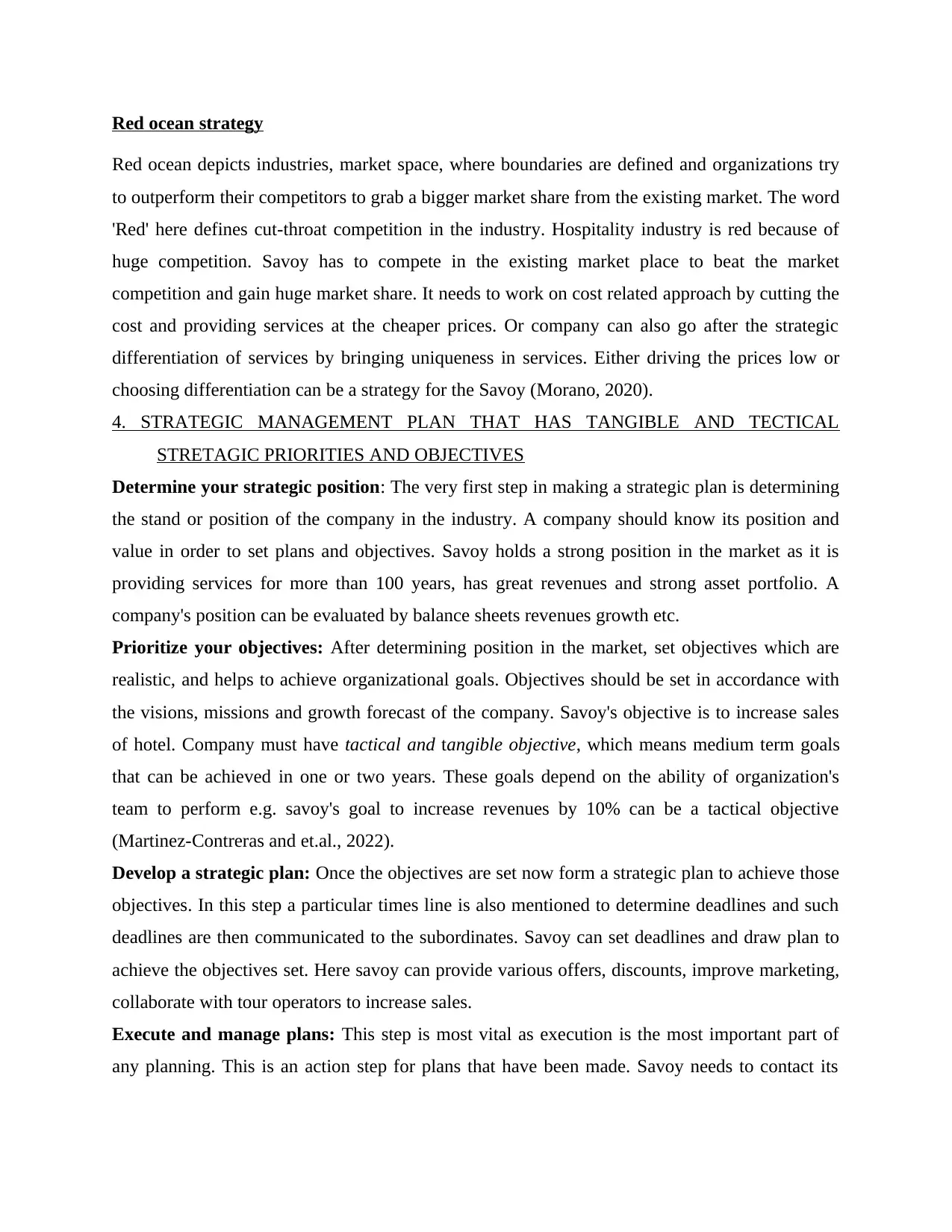
Red ocean strategy
Red ocean depicts industries, market space, where boundaries are defined and organizations try
to outperform their competitors to grab a bigger market share from the existing market. The word
'Red' here defines cut-throat competition in the industry. Hospitality industry is red because of
huge competition. Savoy has to compete in the existing market place to beat the market
competition and gain huge market share. It needs to work on cost related approach by cutting the
cost and providing services at the cheaper prices. Or company can also go after the strategic
differentiation of services by bringing uniqueness in services. Either driving the prices low or
choosing differentiation can be a strategy for the Savoy (Morano, 2020).
4. STRATEGIC MANAGEMENT PLAN THAT HAS TANGIBLE AND TECTICAL
STRETAGIC PRIORITIES AND OBJECTIVES
Determine your strategic position: The very first step in making a strategic plan is determining
the stand or position of the company in the industry. A company should know its position and
value in order to set plans and objectives. Savoy holds a strong position in the market as it is
providing services for more than 100 years, has great revenues and strong asset portfolio. A
company's position can be evaluated by balance sheets revenues growth etc.
Prioritize your objectives: After determining position in the market, set objectives which are
realistic, and helps to achieve organizational goals. Objectives should be set in accordance with
the visions, missions and growth forecast of the company. Savoy's objective is to increase sales
of hotel. Company must have tactical and tangible objective, which means medium term goals
that can be achieved in one or two years. These goals depend on the ability of organization's
team to perform e.g. savoy's goal to increase revenues by 10% can be a tactical objective
(Martinez-Contreras and et.al., 2022).
Develop a strategic plan: Once the objectives are set now form a strategic plan to achieve those
objectives. In this step a particular times line is also mentioned to determine deadlines and such
deadlines are then communicated to the subordinates. Savoy can set deadlines and draw plan to
achieve the objectives set. Here savoy can provide various offers, discounts, improve marketing,
collaborate with tour operators to increase sales.
Execute and manage plans: This step is most vital as execution is the most important part of
any planning. This is an action step for plans that have been made. Savoy needs to contact its
Red ocean depicts industries, market space, where boundaries are defined and organizations try
to outperform their competitors to grab a bigger market share from the existing market. The word
'Red' here defines cut-throat competition in the industry. Hospitality industry is red because of
huge competition. Savoy has to compete in the existing market place to beat the market
competition and gain huge market share. It needs to work on cost related approach by cutting the
cost and providing services at the cheaper prices. Or company can also go after the strategic
differentiation of services by bringing uniqueness in services. Either driving the prices low or
choosing differentiation can be a strategy for the Savoy (Morano, 2020).
4. STRATEGIC MANAGEMENT PLAN THAT HAS TANGIBLE AND TECTICAL
STRETAGIC PRIORITIES AND OBJECTIVES
Determine your strategic position: The very first step in making a strategic plan is determining
the stand or position of the company in the industry. A company should know its position and
value in order to set plans and objectives. Savoy holds a strong position in the market as it is
providing services for more than 100 years, has great revenues and strong asset portfolio. A
company's position can be evaluated by balance sheets revenues growth etc.
Prioritize your objectives: After determining position in the market, set objectives which are
realistic, and helps to achieve organizational goals. Objectives should be set in accordance with
the visions, missions and growth forecast of the company. Savoy's objective is to increase sales
of hotel. Company must have tactical and tangible objective, which means medium term goals
that can be achieved in one or two years. These goals depend on the ability of organization's
team to perform e.g. savoy's goal to increase revenues by 10% can be a tactical objective
(Martinez-Contreras and et.al., 2022).
Develop a strategic plan: Once the objectives are set now form a strategic plan to achieve those
objectives. In this step a particular times line is also mentioned to determine deadlines and such
deadlines are then communicated to the subordinates. Savoy can set deadlines and draw plan to
achieve the objectives set. Here savoy can provide various offers, discounts, improve marketing,
collaborate with tour operators to increase sales.
Execute and manage plans: This step is most vital as execution is the most important part of
any planning. This is an action step for plans that have been made. Savoy needs to contact its
Secure Best Marks with AI Grader
Need help grading? Try our AI Grader for instant feedback on your assignments.

marketing department to raise a marketing campaign for increasing sales and contact the tour
operators who buy rooms in bulk.
Review and revise the plan: In this step company needs to review the entire plan and its
implementation. Goals and progress should be tracked to know the productivity of undertaking
the entire process. This step evaluates the achievement of the goals, if not achieved then report
the factors that led to failure (Foroudi and et.al., 2021).
CONCLUSION
In the above report of hospitality business strategy for Savoy, a detailed internal and external
analysis that provides the basis of strategic planning has been discussed. Various analysis models
and methods like SWOT analysis, PESTEL analysis, McKinsey 7S model, porter's 5 forces,
Porter’s generic strategy, ANSOFF matrix, balance scorecard model, red ocean strategy have
been illustrated. A potential best way of expansion for Savoy has been mentioned. Further a
strategic plan based on the environmental analysis has been depicted. The strategies which can
help savoy grow further and understand business model of the same has been studied. Also,
planning in support of savoy's business model has been stated. At last a strategic management
plan has been formed.
operators who buy rooms in bulk.
Review and revise the plan: In this step company needs to review the entire plan and its
implementation. Goals and progress should be tracked to know the productivity of undertaking
the entire process. This step evaluates the achievement of the goals, if not achieved then report
the factors that led to failure (Foroudi and et.al., 2021).
CONCLUSION
In the above report of hospitality business strategy for Savoy, a detailed internal and external
analysis that provides the basis of strategic planning has been discussed. Various analysis models
and methods like SWOT analysis, PESTEL analysis, McKinsey 7S model, porter's 5 forces,
Porter’s generic strategy, ANSOFF matrix, balance scorecard model, red ocean strategy have
been illustrated. A potential best way of expansion for Savoy has been mentioned. Further a
strategic plan based on the environmental analysis has been depicted. The strategies which can
help savoy grow further and understand business model of the same has been studied. Also,
planning in support of savoy's business model has been stated. At last a strategic management
plan has been formed.

REFERENCES
Books and journals
Agarwal, A., 2020. Investigating design targets for effective performance management system:
an application of balance scorecard using QFD. Journal of Advances in Management
Research.
BURKE, K. and et.al., 2020. Developing meta-strategies for hospitality experiences. Managing
Hospitality Experiences. p.141.
Cheng, L. C. and et.al., 2021. User-Defined SWOT analysis–A change mining perspective on
user-generated content. Information Processing & Management. 58(5). p.102613.
Dawes, J., 2018. The Ansoff matrix: A legendary tool, but with two logical problems. But with
Two Logical Problems (February 27, 2018).
Faturrohman, F. and et.al., 2018. Application of RBV Theory and McKinsey 7’S Model on Start-
up Company. Scientific Journal of PPI-UKM. 5(1). pp.1-6.
Firoz Suleman, M. b. and et.al., 2019. The applicability of Porter's generic strategies in pure
online firms: A case study approach. Strategic Change. 28(3). pp.167-176.
Foroudi, P. and et.al., 2021. The gloom of the COVID-19 shock in the hospitality industry: A
study of consumer risk perception and adaptive belief in the dark cloud of a pandemic.
International Journal of Hospitality Management. 92. p.102717.
Gebbels, M., 2018. What the government can do to help the hospitality industry before and after
Brexit?. Brexit Survival Guide: Practical Tips for Hospitality Businesses. pp.25-25.
Gorondutse, A. H. and Hilman, H., 2019. Testing the effect of business-level strategy on
performance of hotels. Global Business Review. 20(5). pp.1141-1154.
Gupta, A. and et.al., 2019. British Airways-A SWOT and PESTLE Analysis-The impact of
Europe 2020 policy. NOLEGEIN-Journal of Corporate & Business Laws. 1(1). pp.1-11.
Ibrahim, N. and et.al., 2018, October. Supplier Performance Measurement for Online Travel
Agent Using Balance Scorecard: Case Study: Klikhotel. com. In 2018 International
Conference on Advanced Computer Science and Information Systems (ICACSIS) (pp.
45-50). IEEE.
Karim, N., 2020. Training and development: a driving force for service quality in hospitality
sector in London, UK (Doctoral dissertation, University of the West of Scotland).
Kim, M., Roehl, W. and Lee, S. K., 2020. Different from or similar to neighbors? An
investigation of hotels' strategic distances. Tourism Management. 76, p.103960.
Lakatos, E. and Arsenopoulos, A., 2019. Investigating EU financial instruments to tackle energy
poverty in households: A SWOT analysis. Energy Sources, Part B: Economics,
Planning, and Policy. 14(6). pp.235-253.
Martinez-Contreras, R. M. And et.al., 2022. Pestel Analysis and the Porter's Five Forces: An
Integrated Model of Strategic Sectors. In Handbook of Research on Organizational
Sustainability in Turbulent Economies (pp. 292-314). IGI Global.
Morano, D. C. E., 2020. Improving sales of a family-owned hospitality business through social
media marketing.
Murphy, K. and et.al., 2018. A review of high performance work practices (HPWPs) literature
and recommendations for future research in the hospitality industry. International
Journal of Contemporary Hospitality Management.
1
Books and journals
Agarwal, A., 2020. Investigating design targets for effective performance management system:
an application of balance scorecard using QFD. Journal of Advances in Management
Research.
BURKE, K. and et.al., 2020. Developing meta-strategies for hospitality experiences. Managing
Hospitality Experiences. p.141.
Cheng, L. C. and et.al., 2021. User-Defined SWOT analysis–A change mining perspective on
user-generated content. Information Processing & Management. 58(5). p.102613.
Dawes, J., 2018. The Ansoff matrix: A legendary tool, but with two logical problems. But with
Two Logical Problems (February 27, 2018).
Faturrohman, F. and et.al., 2018. Application of RBV Theory and McKinsey 7’S Model on Start-
up Company. Scientific Journal of PPI-UKM. 5(1). pp.1-6.
Firoz Suleman, M. b. and et.al., 2019. The applicability of Porter's generic strategies in pure
online firms: A case study approach. Strategic Change. 28(3). pp.167-176.
Foroudi, P. and et.al., 2021. The gloom of the COVID-19 shock in the hospitality industry: A
study of consumer risk perception and adaptive belief in the dark cloud of a pandemic.
International Journal of Hospitality Management. 92. p.102717.
Gebbels, M., 2018. What the government can do to help the hospitality industry before and after
Brexit?. Brexit Survival Guide: Practical Tips for Hospitality Businesses. pp.25-25.
Gorondutse, A. H. and Hilman, H., 2019. Testing the effect of business-level strategy on
performance of hotels. Global Business Review. 20(5). pp.1141-1154.
Gupta, A. and et.al., 2019. British Airways-A SWOT and PESTLE Analysis-The impact of
Europe 2020 policy. NOLEGEIN-Journal of Corporate & Business Laws. 1(1). pp.1-11.
Ibrahim, N. and et.al., 2018, October. Supplier Performance Measurement for Online Travel
Agent Using Balance Scorecard: Case Study: Klikhotel. com. In 2018 International
Conference on Advanced Computer Science and Information Systems (ICACSIS) (pp.
45-50). IEEE.
Karim, N., 2020. Training and development: a driving force for service quality in hospitality
sector in London, UK (Doctoral dissertation, University of the West of Scotland).
Kim, M., Roehl, W. and Lee, S. K., 2020. Different from or similar to neighbors? An
investigation of hotels' strategic distances. Tourism Management. 76, p.103960.
Lakatos, E. and Arsenopoulos, A., 2019. Investigating EU financial instruments to tackle energy
poverty in households: A SWOT analysis. Energy Sources, Part B: Economics,
Planning, and Policy. 14(6). pp.235-253.
Martinez-Contreras, R. M. And et.al., 2022. Pestel Analysis and the Porter's Five Forces: An
Integrated Model of Strategic Sectors. In Handbook of Research on Organizational
Sustainability in Turbulent Economies (pp. 292-314). IGI Global.
Morano, D. C. E., 2020. Improving sales of a family-owned hospitality business through social
media marketing.
Murphy, K. and et.al., 2018. A review of high performance work practices (HPWPs) literature
and recommendations for future research in the hospitality industry. International
Journal of Contemporary Hospitality Management.
1
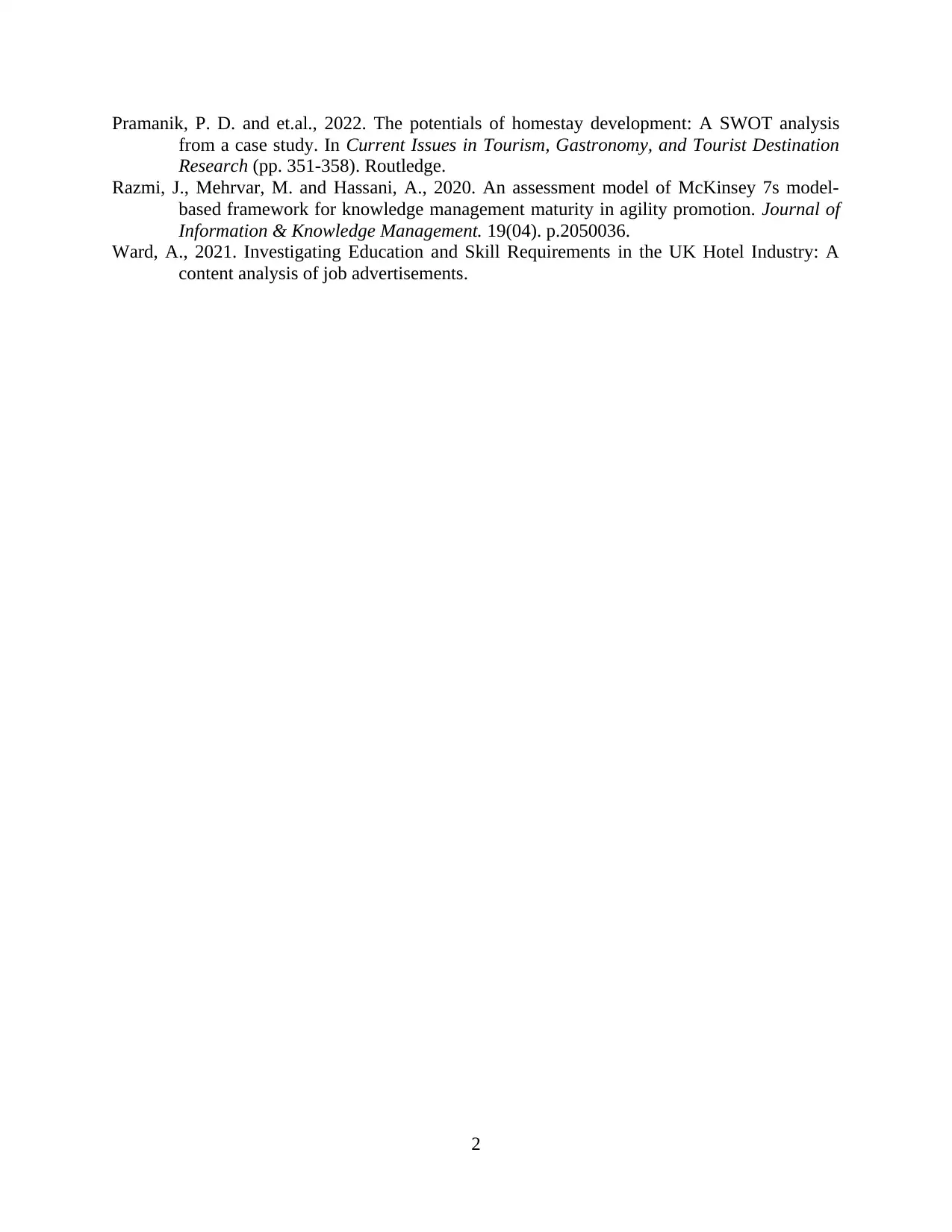
Pramanik, P. D. and et.al., 2022. The potentials of homestay development: A SWOT analysis
from a case study. In Current Issues in Tourism, Gastronomy, and Tourist Destination
Research (pp. 351-358). Routledge.
Razmi, J., Mehrvar, M. and Hassani, A., 2020. An assessment model of McKinsey 7s model-
based framework for knowledge management maturity in agility promotion. Journal of
Information & Knowledge Management. 19(04). p.2050036.
Ward, A., 2021. Investigating Education and Skill Requirements in the UK Hotel Industry: A
content analysis of job advertisements.
2
from a case study. In Current Issues in Tourism, Gastronomy, and Tourist Destination
Research (pp. 351-358). Routledge.
Razmi, J., Mehrvar, M. and Hassani, A., 2020. An assessment model of McKinsey 7s model-
based framework for knowledge management maturity in agility promotion. Journal of
Information & Knowledge Management. 19(04). p.2050036.
Ward, A., 2021. Investigating Education and Skill Requirements in the UK Hotel Industry: A
content analysis of job advertisements.
2
1 out of 13
Related Documents
Your All-in-One AI-Powered Toolkit for Academic Success.
+13062052269
info@desklib.com
Available 24*7 on WhatsApp / Email
![[object Object]](/_next/static/media/star-bottom.7253800d.svg)
Unlock your academic potential
© 2024 | Zucol Services PVT LTD | All rights reserved.



